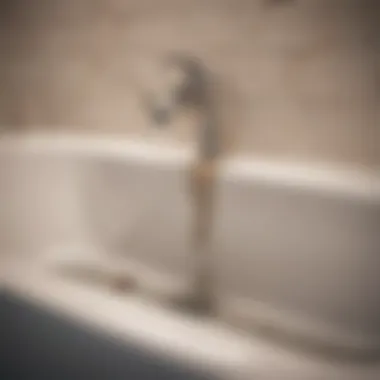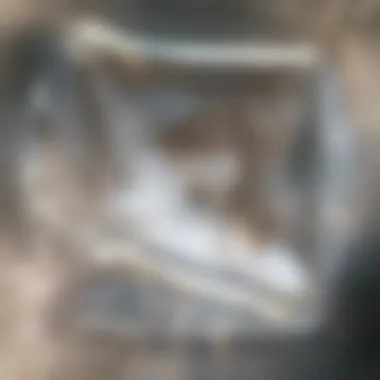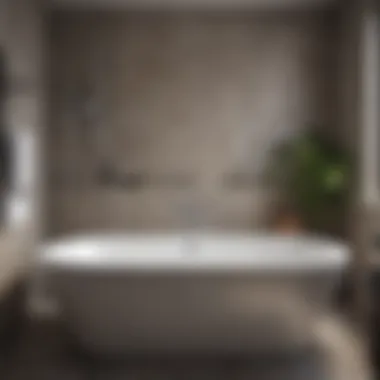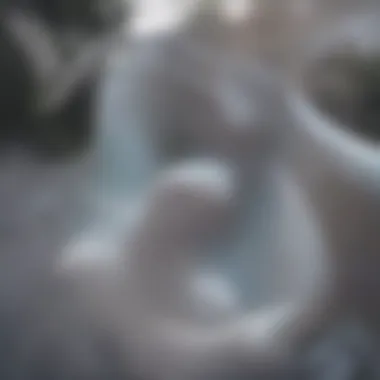Effective Solutions for Slow Bathtub Drainage


Intro
Slow water drainage in bathtubs can be a frustrating experience for homeowners. Understanding the causes behind this issue is essential for effective resolution. Numerous factors contribute to slow drainage, and recognizing these can aid in maintenance and solutions.
The presence of clogs is a common cause. Hair, soap residue, and other debris can accumulate over time, leading to blockages. Plumbing issues are another factor that may affect drainage. Ageing pipes or improper installation can lead to obstructions that hinder water flow.
Additionally, certain architectural designs may influence drainage performance. For instance, bathtubs in locations designed to maximize aesthetics may inadvertently compromise functionality. The aim of this article is to equip readers with the knowledge needed to address drainage issues, enhancing both the performance and appeal of their bathrooms.
Home Design Inspiration
When designing a home, the bathtub is often a focal point in the bathroom. It is not just about aesthetics but also functionality. Selecting the right type of bathtub and positioning it correctly can significantly impact drainage performance.
Architectural Styles
Different architectural styles incorporate bathtubs in various ways. For instance, modern designs often use freestanding tubs that emphasize simplicity and elegance. The plumbing must be meticulously planned to prevent drainage issues. Conversely, more traditional designs may utilize built-in options that may allow for easier installation but can also hide underlying plumbing problems. Understanding these styles can guide homeowners in making informed decisions.
Innovative Decor Trends
In recent years, innovative decor trends have introduced new materials and layouts for bathtubs. For example, materials like acrylic or cast iron can showcase both durability and style. However, it’s crucial to consider how these materials affect drainage. Some materials may have surfaces that trap debris more than others, requiring more frequent maintenance.
Understanding the interplay between style and function is essential in enhancing the overall bathroom experience.
Common Causes of Slow Drainage
Identifying the root causes of slow drainage is the first step toward an effective solution. Here are some common culprits:
- Clogs: Hair, soap scum, and other substances may build up and create blockages.
- Insufficient Pitch: The angle of the plumbing pipes can affect drainage. If pipes are not sloped properly, water will drain slowly.
- Pipe Damage: Cracks or corrosion in pipes can disrupt water flow.
- Ventilation Issues: Proper air circulation helps maintain smooth drainage. Obstructions in the venting system may lead to slower drainage.
Maintenance and Solutions
Regular maintenance is key to preventing drainage issues. Homeowners can take the following steps:
- Use Drain Screens: Installing screens can help catch hair and debris before they enter the drain.
- Regular Cleaning: Periodically removing build-up with a mixture of baking soda and vinegar can keep drains clear.
- Check for Leaks: Inspect pipes and fittings regularly for any signs of water damage.
- Professional Inspections: Engaging a plumber for routine inspections can help identify hidden issues before they escalate.
Each of these solutions contributes to a more effective drainage system, enhancing bathtub use and overall bathroom satisfaction.
Effective maintenance can prevent small issues from becoming larger, costlier problems.
When to Seek Professional Help
Sometimes, DIY solutions may not suffice. If homeowners experience persistent slow drainage despite maintenance efforts, it might be time to consult a professional. A licensed plumber can diagnose underlying issues that may not be visible to the untrained eye. Additionally, they can provide solutions tailored to specific problems regarding plumbing layout and installation.
Understanding the Problem
Understanding slow water drainage in bathtubs is crucial for maintaining a functional and appealing home environment. The implications of this issue extend beyond mere inconvenience. When water drains slowly, it can lead to various complications such as unpleasant odors, potential water damage, and even mold growth. Awareness of these risks encourages homeowners to take proactive measures before issues escalate. Identifying the symptoms and underlying causes can save time and costs associated with repairs or professional interventions. Hence, addressing slow drainage is not just about fixing a problem; it is about safeguarding the integrity of your living space.
Defining Slow Drainage
Slow drainage in a bathtub is characterized by water taking an unusually long time to empty after use. This can happen for a few reasons. When the drainage rate is less than expected, people often experience discomfort. They notice their feet sitting in standing water while bathing, which is usually not the case in well-functioning systems. In technical terms, slow drainage occurs when the outflow capacity is obstructed or impaired. It can result from various factors, including clogs, plumbing issues, or even the design of the drainage system itself. Recognizing this definition is the first step in addressing the problem effectively.
Common Symptoms of Slow Drainage
Several symptoms can indicate a slow drain situation. Some of the most evident include:
- Water Accumulation: Standing water in the tub during or after a bath.
- Gurgling Sounds: Unusual noises when water drains, suggesting air pockets in the pipes.
- Slow Emptying of Water: Noticeable delays compared to usual drainage times.
- Foul Odors: Accumulated residue in drains can emit unpleasant smells.
- Frequent Blockages: Ongoing trouble with clogged drains denote persistent issues.
Each of these symptoms is a signal that should not be ignored. They often point to deeper issues that, if left unattended, may require more extensive repairs or replacements.


Identifying Causes
Understanding the causes behind slow water drainage in bathtubs is crucial for homeowners facing this common plumbing issue. Identifying the root causes can lead to effective solutions. Slow drainage can result from multiple factors. By pinpointing these, homeowners can avoid further damage and costly repairs. Recognizing the driving elements helps in deciding on the right approach.
Clogs and Blockages
Clogs are often the primary reason for slow drainage. Hair accumulation, soap residue, and foreign objects can all contribute significantly.
Hair Accumulation
Hair accumulation is one of the most common causes of clogs in bathtubs. Over time, hair collects in the drain, leading to obstructed flow. This can result in unpleasant odors and water retention during baths. The key characteristic of hair is its ability to bind with other substances. This makes it a very effective agent for blockage formation. Hair is a popular topic in discussions about drains due to its prevalence in residential settings. Its unique feature is that it can trap soap residue and other debris, making the blockage even worse. One disadvantage is that removing hair often requires physical intervention, such as using a drain snake.
Soap Residue
Soap residue builds up over time, creating a sticky layer inside pipes. It is often ignored until it leads to significant slow drainage. A key characteristic of soap residue is its bonding nature, which allows it to accumulate and create thicker buildups. It is beneficial to mention in this article, as many homeowners do not realize its impact. Its unique feature is that it combines with other materials to form a solid mass that restricts water flow. This can be challenging to remove, requiring more extensive cleaning measures.
Foreign Objects
Foreign objects can range from small toys to personal items. These objects can create immediate blockages. The key characteristic is unpredictability since they can enter the drain without notice. Identifying them in this article is essential due to the various factors leading to such blockages. The unique feature of foreign objects is their ability to cause sudden and complete drainage failure. Their removal usually necessitates professional help, which can be a disadvantage in terms of cost and time.
Plumbing Issues
Plumbing issues can also play a significant role in slow drainage. Problems like pipe corrosion, improper slope, and ventilation issues will be examined here.
Pipe Corrosion
Pipe corrosion is a gradual process that weakens plumbing materials. Rusted pipes can narrow the drain's diameter. This leads to reduced flow. The key characteristic of pipe corrosion is that it often goes unnoticed until significant damage occurs. It is a relevant topic in discussions around plumbing. A unique feature is that corroded areas can also harbor bacteria. This can lead to hygiene issues. The disadvantages are frequent need for replacement and repairs, which can become costly over time.
Improper Slope
Proper drainage relies on a correct slope in plumbing systems. An improper slope prevents adequate water flow. The key characteristic of this issue is its technical nature, often overlooked during installation. This topic is significant in the realm of plumbing. Its unique feature is that it can be fixed with professional assessments, but it may require substantial work to correct. The disadvantage involves potential disruption to existing structures.
Ventilation Problems
Ventilation issues can lead to pressure build-up in plumbing systems. This can inhibit drainage performance. The key characteristic is that it affects how air interacts with water flow. In this article, mentioning ventilation acknowledges its importance in drainage systems. A unique feature of ventilation problems is that they can manifest as gurgling noises, a clear sign of a real issue. The disadvantage is that resolving this often requires specialized knowledge and can be complex.
Installation Errors
Installation errors can also hinder proper drainage. Problems such as inadequate drainage systems and faulty fixtures will be discussed.
Inadequate Drainage System
An inadequate drainage system is a fundamental cause of slow drainage in bathtubs. The key characteristic is that not all systems are equipped to handle high water flow. Identifying this is vital to understanding why some homes experience persistent drainage issues. Its unique aspect is that correcting it may involve structural changes and upgrades. The disadvantage is the expense associated with professional assessment and potential renovations.
Faulty Fixtures
Faulty fixtures, such as drains and plugs, can lead to water pooling in bathtubs. The key characteristic of these fixtures is that they can be manufactured incorrectly or wear down over time. This article highlights the relevance of fixture quality. The unique feature of faulty fixtures is their potential to create ongoing water issues without visible signs. The disadvantage is that even minor faults can lead to significant drainage problems long-term.
Assessing the Severity
Understanding the severity of slow drainage is crucial. It helps determine whether a simple DIY solution can resolve the issue or if professional help is necessary. Homeowners must assess the drainage problem thoroughly to avoid larger plumbing concerns that may arise from neglect. An effective assessment can save time, money, and frustration in the long run. It also ensures the home environment remains comfortable and functional.
DIY Assessment Techniques
Water Anomaly Observations
Observing any unusual signs in the water flow gives valuable information. Look for water pooling around the bathtub or slow receding after use. Such anomalies are often indicators of deeper plumbing issues, making this assessment a critical part of troubleshooting.


The key characteristic of water anomaly observations is their simplicity. Homeowners can easily monitor the flow of water without specialized tools. The significant benefit is the immediacy of results; changes in behavior can prompt an earlier intervention to avoid exacerbating the issue.
However, relying solely on these observations can have disadvantages. Sometimes the problem can be misleading, requiring more in-depth assessment method. Yet, it remains a good starting point for identifying potential drainage problems.
Draining Rate Measurement
The draining rate measurement is a practical technique. Measure how long it takes for a specific amount of water to empty from the tub. A slower rate than usual signals a drainage problem that needs addressing.
The primary benefit of this method is its objectivity. Homeowners can quantify exactly how slow the drainage has become. This precise data can signal the need for prompt interventions or solutions.
While this measurement is straightforward, it does require some patience for the process. Sometimes, slow rates might vary with usage patterns. Therefore, repeating the measurement over different periods can yield a clearer picture. Ultimately, this technique provides data to assess the immediate effectiveness of any DIY fixes applied.
When to Seek Professional Help
Persistent Slow Drainage
If slow drainage remains after DIY efforts, it's time to consider professional help. Persistent slow drainage issues often indicate deeper blockages or plumbing failures. These can range from root invasions to severe pipe corrosion – tasks beyond mere home solutions.
A key characteristic of persistent issues is that they often escalate if not addressed timely. Homeowners benefit from seeking expert services for thorough inspections to identify root causes. Professional intervention may, in fact, not only resolve the current problem but also prevent future issues from emerging, resulting ultimately in long-term savings.
However, engaging professionals also entails costs. This aspect can deter some homeowners from taking action until the problem worsens. Despite the cost, the benefits often outweigh the initial expenditure if it resolves ongoing issues.
Multiple Fixtures Ill-Equipped
If multiple plumbing fixtures are facing drainage difficulties simultaneously, this signalizes a systemic issue that requires attention. This situation reflects potential multi-faceted plumbing problems, which can arise from improper installation or overall plumbing design flaws.
The unique feature of this scenario is that it points to underlying conditions that might go unnoticed with isolated assessments. Identifying these issues early can prevent more drastic problems later, maintaining the integrity of the plumbing system.
Though multiple fixtures indicate a systematic issue, tackling it may require extensive evaluation and costly repairs. Thus, recognizing when to involve professionals based on systematic failures is crucial for a homeowner's long-term planning.
Practical Solutions
Addressing slow water drainage in bathtubs requires a focus on practical solutions. Finding effective remedies can restore the functionality of these essential fixtures. Implementing solutions not only resolves immediate issues but also contributes to long-term maintenance and efficiency. Whether choosing simple DIY techniques or hiring professionals, effective solutions are crucial for minimising future problems.
DIY Remedies for Clogs
Plunger Technique
The plunger technique is one of the most accessible methods for tackling clogs in bathtubs. This technique involves using a rubber suction cup on a stick. The goal is to create a vacuum that dislodges debris causing the blockage. It is popular because of its simplicity and effectiveness. Most households have a plunger, making it a readily available tool. The unique feature of the plunger is its ability to exert force without the need for chemicals. However, it may not work on all types of clogs, especially those that are more severe or deeper in the plumbing system.
Homemade Drain Cleaners
Homemade drain cleaners offer another avenue for resolving slow drainage. These cleaners typically consist of common household ingredients like baking soda, vinegar, and salt. The value of ingredients lies in their ability to break down simple clogs naturally. Additionally, homemade solutions are often gentler on pipes compared to commercial products. A key characteristic is the ease of preparation. Simply mixing the ingredients and pouring them down the drain can provide a quick solution. Nevertheless, these cleaners may not always be effective on tougher blockages and could require multiple attempts.
Mechanical Approaches
Snake Drain Tool
The Snake Drain Tool is a specialized device designed to clear blockages within plumbing lines. The tool is a flexible metal auger that can reach deep into drain pipes. Its significance lies in its ability to remove stubborn clogs that typical remedies might miss. A notable advantage is its versatility; it can be used on various drains in the house. However, using the Snake Drain Tool requires some skill to navigate bends in the plumbing. Improper use can potentially damage the pipes.
Hydro Jetting Services
Hydro jetting services use high-pressure water jets to clear clogs and debris from drains. This technique is particularly effective for extensive buildup and grease. One of the main advantages is its thoroughness, as it can clean the entire pipe, leaving no residue behind. While hydro jetting is beneficial for severe clogs, it is often performed by professionals and can be more expensive than DIY methods. Additionally, not all plumbing systems can handle the pressure of a hydro jetting service, which makes proper assessment vital prior to use.
Preventative Measures
Preventative measures are essential in maintaining optimal bathtub functionality and addressing slow drainage issues before they escalate. Understanding these measures allows homeowners to take proactive steps, ensuring a pleasant bathing experience. The importance of preventative measures lies not only in avoiding immediate problems but also in extending the life of plumbing systems and reducing long-term costs.


Implementing simple, yet effective practices can create a more efficient drainage system. Homeowners can enjoy peace of mind knowing they are minimizing the risk of clogs and blockages.
Routine Maintenance Practices
Regular Cleaning Schedules
Regular cleaning schedules focus on routine upkeep of the bathtub and drainage system. This contributes to preventing build-up that leads to slow drainage. Establishing a consistent cleaning routine helps in maintaining overall hygiene.
The key characteristic of regular cleaning schedules is their reliability. Cleaning the bathtub and pipes on a set timetable ensures that small issues do not turn into larger problems later. This is a popular choice among homeowners who wish to maintain function and cleanliness in their bathrooms.
A unique feature of regular cleaning is that it can be tailored to fit individual needs. Some may prefer a weekly basis, while others might choose bi-weekly depending on usage. The advantages of a regular cleaning schedule include reduced risk of clogs, improved hygiene, and a more pleasant space to enjoy.
Using Drain Screens
Using drain screens serves as a practical solution for slowing down the accumulation of debris in the drain. This method captures hair and soap residue, allowing for easier disposal instead of allowing it to go down the drain. This contributes significantly to the overall goal of preventing slow drainage.
The key characteristic of using drain screens is their simplicity. They are easy to install and require minimal maintenance. This makes them a beneficial choice for any homeowner looking to enhance their drainage system.
One unique feature of drain screens is their availability in various sizes and designs. This variety allows homeowners to select screens that best fit their specific bathtubs and personal styles. The advantages of using drain screens include lower maintenance costs and a decreased likelihood of needing more serious plumbing interventions down the line. However, they can become clogged themselves if not cleaned regularly, which necessitates some oversight.
Long-term Solutions
Long-term solutions offer a more permanent approach to ensuring effective drainage in bathtubs. These considerations typically involve larger investments that can yield significant benefits in functionality over time.
Upgrading Plumbing Fixtures
Upgrading plumbing fixtures, such as faucets or drains, can provide a significant improvement in water flow and drainage efficiency. This contributes to the overarching goal of preventing slow drainage by addressing potential bottlenecks in the system.
The key characteristic of upgrading plumbing fixtures is their ability to modernize the system. Newer fixtures often come with improved designs that help in reducing or eliminating drainage issues. This is a popular choice since old fixtures can lead to inefficiencies and frequent repairs.
A unique feature of upgrading fixtures is the opportunity to select products that meet modern safety and environmental standards. The advantages include enhanced performance, stylish designs, and greater water efficiency. However, one disadvantage might be the initial cost associated with purchasing new units and the installation process.
Implementing Professional Inspections
Implementing professional inspections offers a thorough examination of the entire plumbing system, which aims to detect any underlying problems before they become substantial issues. This contributes significantly to maintaining optimal performance of bathtubs and drainage systems.
The key characteristic of professional inspections is the expertise that trained plumbers bring. They have the skills needed to identify problems that a general homeowner might overlook. This choice can save time and prevent costly future repairs.
A unique feature of professional inspections is the personalized advice provided based on specific issues found in the plumbing system. Homeowners gain insights tailored to their circumstances. The advantages of professional inspections include early identification of issues and the assurance of a functioning drainage system. However, a disadvantage could be the cost of hiring professional services, which some may find prohibitive.
Ensuring efficient bathtub drainage requires a combination of routine maintenance and thoughtful upgrades. By adopting these preventative measures, homeowners can enhance the functionality of their bathrooms while reducing potential issues.
Final Considerations
Addressing slow water drainage in bathtubs is essential for maintaining both the functionality and aesthetic appeal of your home. As homeowners and design enthusiasts, understanding the importance of effective drainage contributes to overall satisfaction with your living space. This section emphasizes specific elements to consider, the benefits of effective solutions, and important considerations as you resolve slower drainage issues.
Evaluating Effectiveness of Solutions
When tackling the problem of slow drainage, evaluating the effectiveness of your chosen solutions is critical. After implementing remedies or maintenance practices, it is vital to observe any changes in drainage performance. Monitoring water flow is an excellent first step. Determine if water drains at an improved rate compared to before. It may involve timing how long it takes for the tub to empty after a bath. If the situation has improved, you can be assured that the solution worked.
However, persistence in the slow drainage issue may indicate that your attempts were not fully effective. In such cases, further assessment of the chosen methods is necessary. Consider the nature of the problem. Technical defects like pipe sloping may require professional input.
Moreover, it's essential to keep a detailed record of previous attempts at solving the issue. Document which methods were employed, the outcome, and any observable changes. This systematic approach helps refine future strategies, leading to continuous improvement in drainage solutions.
Maintaining Drainage Efficiency
Once effective solutions have been implemented to address slow drainage, regular maintenance becomes vital. Maintaining drainage efficiency not only prevents reoccurrence of problems but also promotes longevity of plumbing systems. Here are several strategies to ensure ongoing efficiency:
- Routine Cleaning: Regularly scouring the drain area can prevent dirt and debris from building up.
- Use Drain Screens: Installing screens helps catch hair and foreign objects before they enter the plumbing.
- Schedule Professional Inspections: Enlisting help from plumbing professionals for periodic check-ups can identify potential issues early.
Incorporating these practices reduces the likelihood of new blockages forming while prolonging the life of your plumbing fixtures.
Furthermore, staying aware of unusual changes in drainage or any emerging symptoms is crucial. Address minor issues promptly before they escalate into significant concerns.







